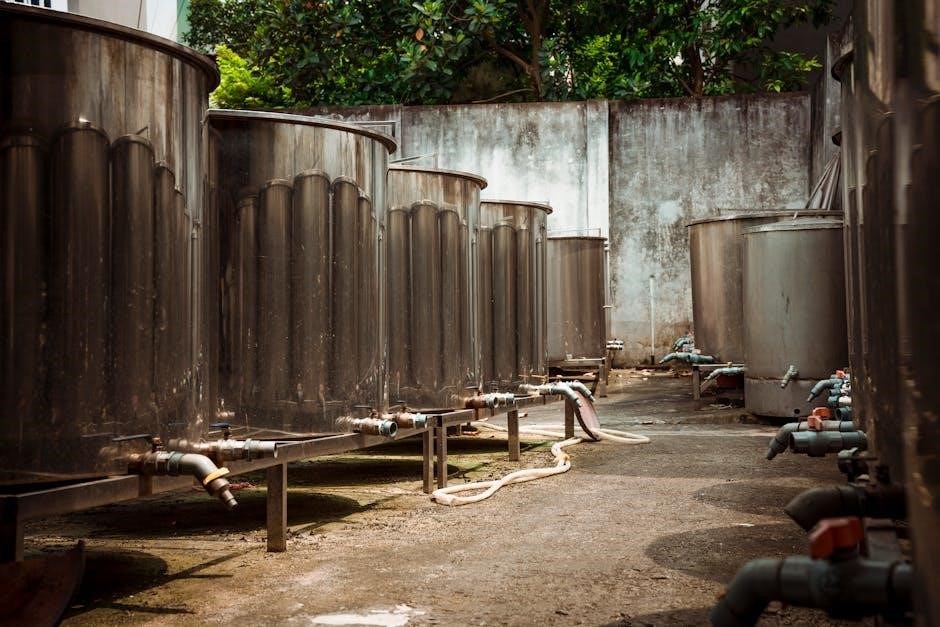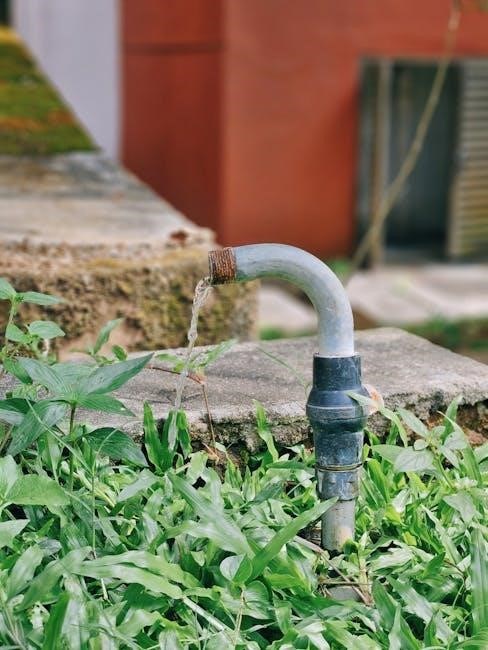
Importance of Proper Water Supply Pipe Sizing

Proper water supply pipe sizing ensures safe drinking water, prevents contamination risks, and maintains optimal flow rates. It is critical for safeguarding public health and preventing costly system failures or property damage.
1.1 Protection of Human Health
Proper water supply pipe sizing is vital for protecting public health. Correctly sized pipes ensure a consistent water flow, reducing the risk of stagnation and contamination. Stagnant water can harbor harmful bacteria, posing serious health risks. Additionally, proper sizing minimizes backflow potential, preventing contaminated water from entering the supply system. This safeguard is essential for maintaining clean drinking water and preventing waterborne diseases. By adhering to sizing standards, plumbers can ensure a safe and reliable water supply, protecting the well-being of building occupants. Proper sizing also supports compliance with health regulations, ensuring a hygienic environment for all users.
1.2 Ensuring Adequate Water Supply and Pressure
Proper water supply pipe sizing ensures that all fixtures and appliances receive adequate water flow and pressure. Undersized pipes can lead to insufficient pressure, causing poor performance of fixtures like showers and faucets. Oversized pipes, while ensuring pressure, may increase costs unnecessarily. Correct sizing balances these factors, providing consistent pressure and flow rates. This ensures functionality across all points of use, from residential fixtures to commercial systems. Adequate sizing also prevents pressure drops, which can damage equipment or lead to system inefficiencies. Properly sized pipes guarantee reliable water distribution, meeting the demands of both everyday use and peak consumption periods. This ensures a consistent and efficient water supply system.

Steps in Water Supply Pipe Sizing Calculation
The process involves assigning water supply fixture units, determining flow rates, calculating friction loss, and selecting appropriate pipe diameters to ensure efficient water distribution and pressure maintenance.
2.1 Assigning Water Supply Fixture Units (WSFU)
Assigning Water Supply Fixture Units (WSFU) is the first step in pipe sizing. Each plumbing fixture, such as sinks, toilets, and showers, is assigned a specific WSFU value based on its water demand. These values are typically found in plumbing codes like the UPC or IPC. For example, a sink might have a WSFU of 1, while a toilet could be rated at 3. The total WSFU is calculated by summing the values for all fixtures, considering factors like simultaneous use and flow rates. This step ensures the water supply system is sized correctly to meet demand without excessive pressure drop or oversizing.
2.2 Determining Flow Rate and Pipe Diameter
After assigning WSFU, the next step is calculating the flow rate and selecting the appropriate pipe diameter. The flow rate is determined by summing the WSFU values and applying demand factors, which account for simultaneous fixture usage. Pipe diameter is then selected based on the calculated flow rate, pressure loss limits, and maximum allowable velocity. Charts or formulas, such as the Hazen-Williams equation, are used to ensure the pipe size meets hydraulic requirements. This step ensures efficient water distribution while maintaining adequate pressure and flow rates throughout the system. Proper sizing prevents excessive pressure drop and ensures system performance.

Fixture Units and Their Role in Pipe Sizing
Fixture units are assigned to each plumbing fixture, determining total hydraulic load. They standardize water demand, ensuring accurate pipe sizing and proper system functionality and design efficiency.
3.1 Fixture Unit Allowance Table
A fixture unit allowance table is a standardized guide assigning specific values to plumbing fixtures based on their water demand. Each fixture, such as sinks, toilets, and showers, is allocated a unit reflecting its flow rate and usage patterns. By summing these values, engineers calculate the total hydraulic load for a system. The table ensures consistent sizing by correlating fixture units with recommended pipe diameters and flow rates. It also accounts for simultaneous use, preventing undersizing or oversizing. These tables are often derived from regulations like the Ontario Building Code (OBC) and BS EN 806-3, ensuring compliance and efficiency in water supply systems. Proper use of fixture unit tables guarantees balanced water distribution and minimal pressure loss, critical for system performance and safety.
3.2 Calculating Total Hydraulic Load
Calculating the total hydraulic load involves summing the water supply fixture units (WSFU) for all fixtures in a system. Each fixture, such as sinks or toilets, is assigned a unit based on its water demand. The total load is determined by adding these units and applying a diversity factor to account for simultaneous usage. This step ensures the system can handle peak demand without pressure drops. The calculation also considers maximum flow rates and pressure requirements, ensuring efficient water distribution. Accurate hydraulic load calculation is critical for proper pipe sizing and system performance, complying with standards like OBC and BS EN 806-3.

Pressure Loss Considerations
Pressure loss in water supply systems occurs due to elevation differences and friction in pipes. It must be carefully calculated to ensure adequate water pressure at all points of use.
4.1 Factors Affecting Pressure Loss
Pressure loss in water supply systems is influenced by several factors, including elevation differences, pipe diameter, material roughness, flow rate, and fitting resistances. Longer pipes and smaller diameters increase friction, leading to higher pressure drops. Additionally, the type of pipe material, such as copper or PVC, affects the Hazen-Williams coefficient, which impacts friction loss calculations. Flow rate also plays a role, as higher velocities result in greater energy losses. Fittings like valves and elbows further contribute to pressure loss due to turbulence. Accurate calculation of these factors ensures optimal system design and maintains desired water pressure at all points.
4.2 Friction Loss and Velocity Limits
Friction loss in water supply pipes occurs due to fluid flow resistance, influenced by pipe material, diameter, and flow rate. Velocity limits are critical to prevent excessive pressure drops and erosion. Typical velocity limits for water distribution systems range from 1.5 m/s to 2.4 m/s, depending on the application. Exceeding these limits can lead to noise, pipe damage, and reduced system efficiency. Accurate friction loss calculations ensure proper pipe sizing, maintaining optimal flow rates and pressure. Velocity limits also help prevent water hammer and cavitation, ensuring a stable and reliable water supply system. Proper management of these factors is essential for long-term system performance.

Pipe Material and Its Impact on Sizing
Pipe material significantly affects sizing due to variations in friction loss and flow rates. Hazen-Williams coefficients and other standards guide material-specific calculations to ensure optimal performance.
5.1 Hazen and Williams Coefficient for Different Materials
The Hazen-Williams coefficient is crucial for calculating friction loss in water supply pipes. It varies by material, with higher values indicating lower friction. For example, plastic pipes use C=150, while other materials like copper or PVC may have different coefficients. This factor directly impacts flow rate and pressure loss calculations. Proper selection ensures accurate pipe sizing and optimal system performance. The coefficient is essential for designing efficient water distribution systems, as it influences both velocity and hydraulic load. Material-specific coefficients are standardized to simplify calculations, ensuring compliance with design standards and regulations.
5.2 Plastic Pipes Capacities and Calculations
Plastic pipes are widely used in water supply systems due to their durability and resistance to corrosion. Their capacity is determined by factors such as diameter, pressure rating, and flow rate. The Hazen-Williams equation is often applied to calculate friction loss and ensure optimal sizing. For plastic pipes, the coefficient (C) is typically 150. Proper sizing ensures that the system meets demand while maintaining acceptable velocity limits to prevent noise and erosion. Calculations must also consider maximum allowable pressure and flow rates to ensure reliable performance and compliance with design standards. Accurate sizing is vital for efficient water distribution.

Velocity of Water Flow in Pipes
Maintaining optimal water flow velocity in pipes is crucial for efficient distribution and system longevity. Excessive velocity can cause erosion and noise, while low velocity may lead to stagnation. Proper sizing ensures balance.
6.1 Recommended Velocity Limits
Proper velocity limits are essential for efficient and safe water distribution. Recommended velocity ranges typically vary between 1.5 m/s and 4 m/s for most systems. Higher velocities can cause erosion, noise, and increased friction loss, while lower velocities may lead to stagnation and sediment buildup. For residential systems, velocities below 2.4 m/s are often suggested to minimize wear and tear. In commercial systems, higher velocities up to 3 m/s are generally acceptable. Maintaining optimal flow rates ensures system efficiency, prevents damage, and supports long-term performance. Proper sizing and material selection are critical to achieving these velocity limits.
6.2 Velocity Calculations for Pipe Size Determination
Velocity calculations are crucial for determining the correct pipe size in water supply systems. These calculations involve using the Hazen-Williams equation or other hydraulic formulas to assess flow rates, pressure losses, and pipe diameters. By measuring the volumetric flow rate (Q) and knowing the pipe’s internal diameter, the velocity (V) can be calculated using the formula: V = Q / (π * D² / 4). This ensures pipes are sized to maintain optimal flow velocities, preventing erosion, noise, and excessive pressure drops. Proper velocity calculations also help minimize sediment buildup and ensure efficient system performance.

Examples and Case Studies
This section provides real-world applications of water supply pipe sizing calculations. It includes examples like residential systems and multi-unit buildings, demonstrating how to apply sizing principles effectively.
7.1 Example Calculation for Residential Water Supply
For a small house with two bathrooms, a kitchen, and a washing machine, we assign water supply fixture units (WSFU) to each fixture. The bathroom fixtures (faucets, toilets, showers) total 4.5 WSFU, the kitchen faucet adds 1 WSFU, and the washing machine adds 2 WSFU, giving a total of 7.5 WSFU. Using the fixture unit allowance table, we determine the required flow rate and pipe diameter. For a maximum flow rate of 10 GPM and considering friction loss, a 1-inch pipe diameter is selected. This ensures adequate pressure and flow to all fixtures, avoiding common issues like low water pressure or contamination risks.
7.2 Case Study: Pipe Sizing for a Multi-Unit Building
In a multi-unit residential building with 20 apartments, each equipped with a kitchen, two bathrooms, and a washing machine, the total water supply fixture units (WSFU) were calculated as 12 WSFU per apartment, totaling 240 WSFU. Using the fixture unit allowance table, the maximum flow rate was determined to be 25 GPM. Pipe diameters were selected based on the Hazen-Williams coefficient for PVC material, ensuring minimal friction loss. The main distribution pipes were sized at 2 inches, with branch lines at 1.5 inches. This design ensured compliance with the Ontario Building Code (OBC) and provided optimal water pressure and flow to all units.

Regulations and Standards
Proper water supply pipe sizing must comply with local and international standards, such as the Ontario Building Code (OBC) and BS EN 806-3, ensuring safety and efficiency in water distribution systems.
8.1 Ontario Building Code (OBC) Requirements
The Ontario Building Code (OBC) mandates specific guidelines for water supply pipe sizing to ensure system safety and efficiency. It requires calculations based on fixture units and hydraulic load, referencing tables like OBC Div. B Table 7.6.3.2.A. The code emphasizes proper sizing to maintain adequate pressure and flow rates, preventing contamination risks. Compliance ensures systems meet minimum standards for material quality and installation, safeguarding public health and property. Designers must adhere to these regulations to avoid legal and operational issues. Proper documentation and approval are essential for compliance.
8.2 Compliance with BS EN 806-3 Standards
Compliance with BS EN 806-3 standards ensures water supply pipe sizing meets European regulations for design and installation. The standard provides a simplified method for sizing pipes, focusing on flow rates, pressure losses, and material compatibility. It requires assigning fixture units, calculating demand, and selecting pipe diameters based on hydraulic load. The standard also includes tables for different materials, such as copper and PE-X, to determine appropriate sizes. Adherence to BS EN 806-3 guarantees system efficiency, water quality, and safety. Designers must follow these guidelines to ensure installations meet legal and performance requirements across Europe. Proper documentation is essential for compliance verification.